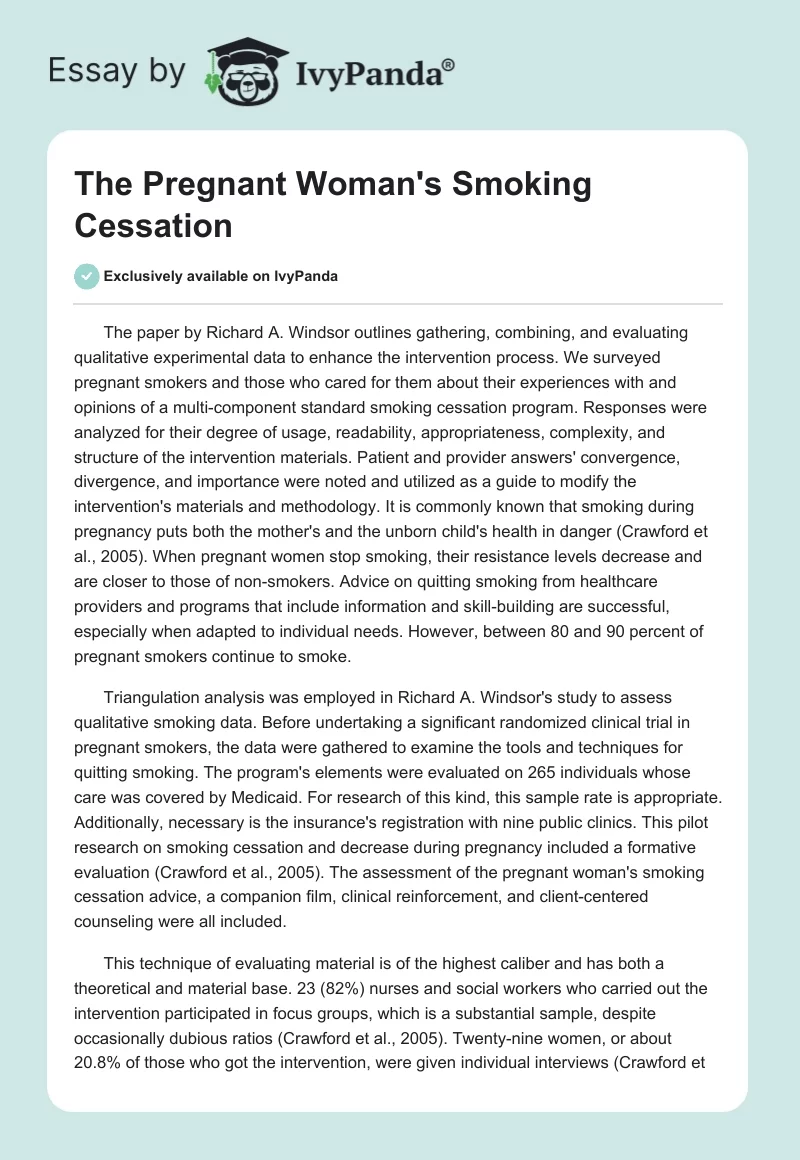The paper by Richard A. Windsor outlines gathering, combining, and evaluating qualitative experimental data to enhance the intervention process. We surveyed pregnant smokers and those who cared for them about their experiences with and opinions of a multi-component standard smoking cessation program. Responses were analyzed for their degree of usage, readability, appropriateness, complexity, and structure of the intervention materials. Patient and provider answers’ convergence, divergence, and importance were noted and utilized as a guide to modify the intervention’s materials and methodology. It is commonly known that smoking during pregnancy puts both the mother’s and the unborn child’s health in danger (Crawford et al., 2005). When pregnant women stop smoking, their resistance levels decrease and are closer to those of non-smokers. Advice on quitting smoking from healthcare providers and programs that include information and skill-building are successful, especially when adapted to individual needs. However, between 80 and 90 percent of pregnant smokers continue to smoke.
Triangulation analysis was employed in Richard A. Windsor’s study to assess qualitative smoking data. Before undertaking a significant randomized clinical trial in pregnant smokers, the data were gathered to examine the tools and techniques for quitting smoking. The program’s elements were evaluated on 265 individuals whose care was covered by Medicaid. For research of this kind, this sample rate is appropriate. Additionally, necessary is the insurance’s registration with nine public clinics. This pilot research on smoking cessation and decrease during pregnancy included a formative evaluation (Crawford et al., 2005). The assessment of the pregnant woman’s smoking cessation advice, a companion film, clinical reinforcement, and client-centered counseling were all included.
This technique of evaluating material is of the highest caliber and has both a theoretical and material base. 23 (82%) nurses and social workers who carried out the intervention participated in focus groups, which is a substantial sample, despite occasionally dubious ratios (Crawford et al., 2005). Twenty-nine women, or about 20.8% of those who got the intervention, were given individual interviews (Crawford et al., 2005). This method of providing healthcare and looking after expectant mothers is fantastic. Qualitative data compared and contrasted providers and patients with the presentation, component use, and program impact. The intervention was improved using the data to boost staff and patient receptivity. This strategy is appropriate in this situation to shorten the time needed for a busy team and ensure that the participants understand.
The study demonstrates particular outcomes, drawing numerous significant findings from the work. Many surveyed people live in a setting that necessitates paying closer attention to the immediate hazards and expenses of everyday existence: the short-term health hazards and less obvious impacts of smoking pale compared to this (Crawford et al., 2005). When preparing materials, it is essential to consider the apparent disparities between patients’ lives in rural and urban locations. One service provider said that a thriving black lady frightened their black consumers (Crawford et al., 2005). At times, a black social worker at a rural clinic admitted that he had to persuade black clients that his experiences were similar to theirs to get them to talk about themselves.
Participants respond differently to various staff. When examining patient flow, SCRIPT staff discovered that some participants gave different answers to other staff members when asked about their smoking status. The quantities reported to additional workers often varied when use was recognized. In contrast to nurses, social workers were the target of the trick. Participants expressed concern that the social worker would inform the social services department that they were terrible parents (Crawford et al., 2005). This emotion, in particular, was brought on by smoking while pregnant, and they ran the risk of losing Medicaid or parental rights. This discovery significantly impacts the search for pregnant smokers. It is essential to consider the questions that various experts pose regarding smoking.
Reference
Crawford, M. A., Woodby, L. L., Russell, T. V., & Windsor, R. A. (2005). Using Formative Evaluation to Improve a Smoking Cessation Intervention for Pregnant Women. Health Communication, 17(3), 265–281. Web.


